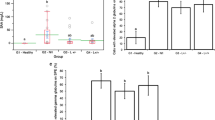Abstract
Strongylus vulgaris is the most pathogenic helminth parasite of horses, causing verminous endarteritis with thromboembolism and infarction. A serum enzyme-linked immunosorbent assay (ELISA) has been validated for detection of antibodies to an antigen produced by migrating larvae of this parasite. The aim was to evaluate ELISA responses to anthelmintic treatment in cohorts of naturally infected horses. Fifteen healthy horses harboring patent S. vulgaris infections were turned out for communal grazing in May 2013 (day 0). On day 55, horses were ranked according to ELISA titers and randomly allocated to the following three groups: no treatment followed by placebo pellets daily; ivermectin on day 60 followed by placebo pellets daily; or ivermectin on day 60 followed by daily pyrantel tartrate. Fecal and serum samples were collected at ∼28-day intervals until study termination on day 231. Increased ELISA values were observed for the first 53 days following ivermectin treatment. Titers were significantly reduced 80 days after ivermectin treatment. Horses receiving daily pyrantel tartrate maintained lower ELISA values from 137 days post ivermectin treatment until trial termination. These results illustrate that a positive ELISA result is indicative of either current or prior exposure to larval S. vulgaris infection within the previous 5 months.


Similar content being viewed by others
References
Abbott JB, Mellor DJ, Barrett EJ, Proudman CJ, Love S (2008) Serological changes observed in horses infected with Anoplocephala perfoliata after treatment with praziquantel and natural reinfection. Vet Rec 162:50–53. doi:10.1136/vr.162.2.50
Andersen UV, Howe DK, Dangoudoubiyam S, Toft N, Reinemeyer CR, Lyons ET, Olsen SN, Monrad J, Nejsum P, Nielsen MK (2013) SvSXP: a Strongylus vulgaris antigen with potential for prepatent diagnosis. Parasites Vector 6:84. doi:10.1186/1756-3305-6-84
Boxell AC, Gibson KT, Hobbs RP, Thompson RCA (2004) Occurrence of gastrointestinal parasites in horses in metropolitan Perth, Western Australia. Aust Vet J 82:91–95. doi:10.1111/j.1751-0813.2004.tb14653.x
Davison AC (1997) Bootstrap methods and their application. Cambridge University Press, Cambridge
Duncan JL (1974) Strongylus vulgaris infection in the horse. Vet Rec 95:34–37. doi:10.1136/vr.95.2.34
Duncan JL, Pirie HM (1972) The life-cycle of Strongylus vulgaris in the horse. Res Vet Sci 13:374–379
Duncan JL, Pirie HM (1975) The pathogenesis of single experimental infections with Strongylus vulgaris in foals. Res Vet Sci 18:82–93
Enigk K (1951) Die Pathogenese der thrombotisch-embolische Kolik des Pferdes. Monatsh Tierheilk 3:65–74
Herd RP (1990) The changing world of worms-the rise of the cyathostomes and the decline of Strongylus vulgaris. Comp Cont Educ Pract Vet 12:482–485
Höglund J, Ljungstrom BL, Nilsson O, Lundquist H, Osterman E, Uggla A (1997) Occurrence of Gasterophilus intestinalis and some parasitic nematodes of horses in Sweden. Acta Vet Scand 38:157–165
Love S, Duncan JL (1991) Could the worms have turned? Equine Vet J 23:152–154
Nielsen MK, Peterson DS, Monrad J, Thamsborg ST, Olsen SN, Kaplan RM (2008) Detection and semi-quantification of Strongylus vulgaris DNA in equine faeces by real-time PCR. Int J Parasitol 38:443–453. doi:10.1016/j.ijpara
Nielsen MK, Olsen SN, Lyons ET, Monrad J, Thamsborg SM (2012) Real-time PCR evaluation of Strongylus vulgaris in horses on farms in Denmark and Central Kentucky. Vet Parasitol 190:461–466. doi:10.1016/j.vetpar.2012.07.018
Nielsen MK, Vidyashankar AN, Gravatte HS, Bellaw J, Lyons ET, Andersen UV (2014) Development of Strongylus vulgaris-specific serum antibodies in naturally infected foals. Vet Parasitol 200:265–270. doi:10.1016/j.vetpar.2013.12.024
Pilo C, Altea A, Pirino S, Nicolussi P, Varcasia A, Genchi M, Scala A (2012) Strongylus vulgaris (Looss, 1900) in horses in Italy: is it still a problem? Vet Parasitol 184:161–167. doi:10.1016/j.vetpar.2011.09.016
Proudman CJ, Trees AJ (1996) Use of excretory/secretory antigens for the serodiagnosis of Anoplocephala perfoliata cestodosis. Vet Parasitol 61:239–247. doi:10.1016/0304-4017(95)00837-3
Slocombe JOD, McCraw BM (1984) Evaluation of ivermectin against later fourth-stage Strongylus vulgaris in ponies at two and five weeks after treatment. Can J Comp Med 48:343–348
Slocombe JOD, McCraw BM, Pennock PW, Ducharme N, Baird JD (1987) Strongylus vulgaris in the tunica media of arteries of ponies and treatment with ivermectin. Can J Vet Res 51:232–235
Stoll NR (1930) On methods of counting nematode ova in sheep dung. Parasitology 22:116–136
Acknowledgments
This study was supported financially by Farnam Companies, Inc. The authors are grateful to Dr. Tom Kennedy for his sponsorship.
Conflict of interest
The authors declare no conflicts of interest.
Author information
Authors and Affiliations
Corresponding author
Rights and permissions
About this article
Cite this article
Nielsen, M.K., Vidyashankar, A.N., Bellaw, J. et al. Serum Strongylus vulgaris-specific antibody responses to anthelmintic treatment in naturally infected horses. Parasitol Res 114, 445–451 (2015). https://doi.org/10.1007/s00436-014-4201-5
Received:
Accepted:
Published:
Issue Date:
DOI: https://doi.org/10.1007/s00436-014-4201-5



